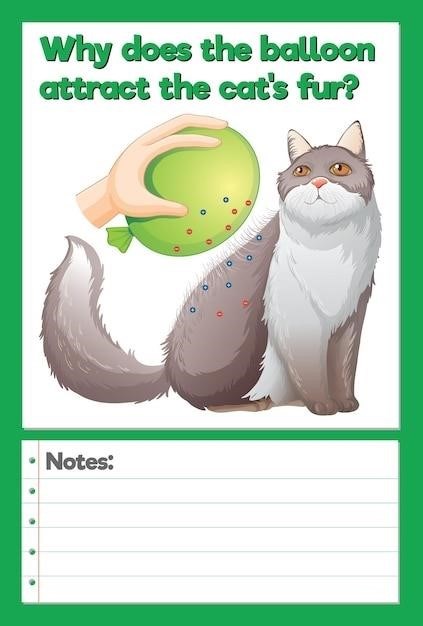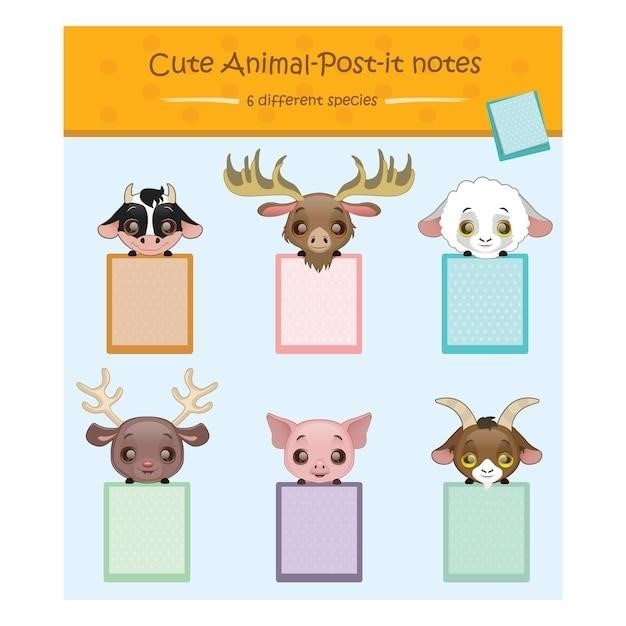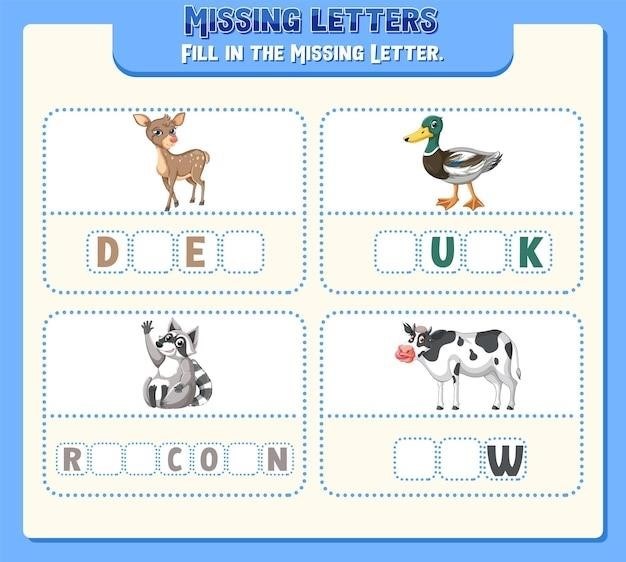Click, Clack, Moo⁚ Cows That Type
Click, Clack, Moo⁚ Cows That Type is a popular children’s book by Doreen Cronin․ It tells the story of cows who use a typewriter to communicate their demands to Farmer Brown․ The cows want electric blankets to keep warm in the barn․ The book explores themes of communication, self-advocacy, and the importance of compromise․ It is a fun and engaging read for children of all ages․ You can find a free PDF version of the book on the internet․
Overview
Click, Clack, Moo⁚ Cows That Type is a beloved children’s book that tells the story of a group of cows who use a typewriter to communicate their demands to Farmer Brown․ The book follows the cows’ journey as they learn to type, write letters, and negotiate with their farmer․ The cows’ demands are simple⁚ they want electric blankets to keep warm in the barn․ However, Farmer Brown is initially hesitant to give in to their requests․ The story unfolds as the cows, fueled by their desire for comfort and fairness, persist in their efforts, eventually leading to a resolution that satisfies both the cows and Farmer Brown․
Click, Clack, Moo⁚ Cows That Type is a charming and engaging tale that celebrates the power of communication, self-advocacy, and compromise․ The book’s humor, relatable characters, and delightful illustrations make it a perfect read for young children․ The story’s themes resonate with readers of all ages, highlighting the importance of understanding and respecting others’ needs and finding common ground to reach a mutually beneficial agreement․
The Story of Click, Clack, Moo
The story begins on a seemingly ordinary farm where Farmer Brown tends to his cows, hens, and ducks․ The cows, however, are not content with their current living conditions․ They find an old typewriter in the barn and decide to use it to communicate their grievances to Farmer Brown․ The cows’ first letter, “Dear Farmer Brown, The barn is very cold at night․ We’d like some electric blankets․ Sincerely, The Cows,” is a simple yet powerful statement of their needs․ Farmer Brown, initially skeptical and amused by the idea of cows typing, dismisses their request․
Undeterred, the cows continue to use the typewriter to express their dissatisfaction․ They even go on strike, refusing to produce milk until their demand for electric blankets is met․ The story takes a humorous turn as the hens and ducks join the cows’ protest, adding their own demands for electric blankets and heated coops․ Farmer Brown, faced with the prospect of no milk, eggs, or duck eggs, finally relents and provides the animals with their desired electric blankets․ The story concludes with the farm restored to harmony, the animals enjoying the comfort of their new blankets, and Farmer Brown learning the importance of listening to his animals’ needs․

The Cows’ Demands
The cows’ primary demand in “Click, Clack, Moo” is for electric blankets․ They find themselves shivering in the cold barn at night, and they believe that electric blankets would provide them with the warmth and comfort they need․ Their request is straightforward and practical, reflecting a basic desire for a better quality of life․ The cows’ demands extend beyond just warmth․ They also want recognition and respect from Farmer Brown․ By using the typewriter to communicate their needs, they are asserting their right to be heard and to have their concerns addressed․ The cows’ demands highlight a universal theme⁚ the importance of self-advocacy and the right to express one’s needs in a clear and assertive manner․
Their decision to go on strike, refusing to produce milk until their demands are met, further emphasizes their determination and willingness to fight for what they believe in․ The cows’ strike is a powerful symbol of their collective strength and their ability to use their collective power to influence change․ The cows’ demands are not unreasonable or excessive; they are simply a reflection of their desire for a more comfortable and fulfilling life․
The Hens and Ducks Join the Strike
As the cows’ strike for electric blankets gains momentum, the hens and ducks on Farmer Brown’s farm recognize the power of collective action․ They see the cows’ success in using the typewriter to communicate their demands and achieve their goals․ The hens, feeling the chill of the cold barn themselves, decide to join the strike, demanding electric blankets for their coop․ The ducks, ever the opportunists, also join the movement, hoping to secure some warm, comfortable water for themselves․ The hens and ducks’ decision to join the strike demonstrates the power of solidarity and the potential for a united front to achieve shared goals․ Their participation expands the scope of the strike, highlighting the common needs and concerns of all the farm animals․
By joining the cows, the hens and ducks send a clear message to Farmer Brown that they are not willing to tolerate unfair working conditions․ They are demanding their right to a comfortable and safe environment, just like the cows․ The hens and ducks’ involvement in the strike strengthens the animals’ position and increases the pressure on Farmer Brown to address their demands․ Their participation transforms the strike from a single-species movement into a multi-species effort, demonstrating the power of unity and the potential for animals from different backgrounds to work together for a common cause․
Farmer Brown’s Dilemma
Farmer Brown, a man of routine and tradition, finds himself in an unprecedented situation․ His cows, hens, and ducks have all gone on strike, demanding electric blankets and warm water․ He is caught between his desire to maintain the status quo on his farm and the growing demands of his disgruntled animal workforce․ The farm, once a model of efficiency and tranquility, is now in a state of disarray․ The milk isn’t flowing, the eggs aren’t being laid, and the ducks are quacking in protest․ Farmer Brown, accustomed to having things his way, must now confront the reality that he cannot simply ignore his animals’ concerns․
He faces a difficult decision⁚ give in to the animals’ demands and provide them with the comfort they seek, or stand firm and risk further disruption to his farm․ He must consider the economic implications of granting the animals their requests, as well as the potential for setting a precedent for future demands․ The strike has exposed a fundamental flaw in his approach to farm management․ He has taken the animals’ labor for granted, failing to recognize their basic needs for comfort and well-being․ Farmer Brown’s dilemma forces him to re-evaluate his relationship with his animals and consider their perspectives․
The Power of Communication
Click, Clack, Moo⁚ Cows That Type demonstrates the profound power of communication in resolving conflict and achieving desired outcomes․ The cows, initially silenced by their inability to express their needs effectively, discover the transformative power of language․ Through the typewriter, they are able to articulate their grievances clearly and concisely, forcing Farmer Brown to acknowledge their concerns․ The animals’ ability to communicate their needs in a direct and organized manner creates a level playing field, allowing them to negotiate with their employer on an equal footing․
The story highlights the importance of clear and open communication in any relationship, particularly in the workplace․ When individuals feel heard and understood, they are more likely to cooperate and work towards common goals․ The cows’ success in securing electric blankets is a testament to the effectiveness of assertive communication․ By expressing their needs with confidence and conviction, they are able to achieve a positive outcome for themselves and their fellow farm animals․

Themes Explored in Click, Clack, Moo
Click, Clack, Moo⁚ Cows That Type, while seemingly a lighthearted children’s story, delves into complex themes that resonate with readers of all ages․ The book explores the importance of communication, self-advocacy, and the value of compromise․ The cows’ decision to go on strike, refusing to provide milk until their demands for electric blankets are met, highlights the power of collective action and the importance of standing up for what one believes in․ This theme of self-advocacy resonates with readers who may feel powerless in the face of authority figures․
The story also underscores the value of compromise․ While the cows initially demand electric blankets, they eventually settle for a more modest request, demonstrating their willingness to negotiate and find a solution that benefits both parties․ The farmer, initially resistant to the cows’ demands, ultimately recognizes the importance of meeting their basic needs, ultimately establishing a more harmonious relationship with his livestock․ Click, Clack, Moo⁚ Cows That Type teaches children valuable lessons about social justice, fair treatment, and the importance of finding common ground․
The Importance of Self-Advocacy
Click, Clack, Moo⁚ Cows That Type, a delightful children’s book by Doreen Cronin, subtly introduces the powerful concept of self-advocacy․ The story unfolds as the cows, dissatisfied with their cold barn, decide to take matters into their own hands․ They discover a typewriter, a symbol of human communication, and use it to articulate their needs to Farmer Brown․ This act of self-advocacy, a courageous step for animals typically perceived as passive, sets a powerful example for young readers․
Through the cows’ actions, children learn that they have a voice and can make their needs known․ The story encourages them to express their desires and concerns, whether it be for a toy they want or a situation they find unfair․ The cows’ success in securing electric blankets, albeit through a humorous strike, emphasizes the importance of voicing one’s needs and the potential for positive change when individuals stand up for themselves․ The book, therefore, inspires children to be assertive and speak up for what they believe is right, fostering a sense of empowerment and confidence․
The Value of Compromise
Click, Clack, Moo⁚ Cows That Type, by Doreen Cronin, doesn’t just highlight the importance of self-advocacy, it also subtly emphasizes the value of compromise․ While the cows’ initial demands for electric blankets might seem unreasonable to Farmer Brown, the story ultimately leads to a resolution that benefits both parties․ The cows, through their strike, make their needs clear, but they also demonstrate a willingness to negotiate․ Farmer Brown, on the other hand, recognizes the validity of their concerns and responds with a solution that meets their needs while minimizing disruption to his routine․
The book demonstrates that compromise isn’t about giving in, but about finding common ground․ It teaches children that even when they feel strongly about something, they can still find a way to work together with others and reach a mutually agreeable outcome․ The story shows that compromise can lead to a more harmonious and productive relationship, ultimately benefiting everyone involved․ In this light, the book encourages young readers to embrace compromise as a valuable tool for resolving conflicts and building positive relationships․
Click, Clack, Moo as a Tool for Teaching
Click, Clack, Moo⁚ Cows That Type is more than just a fun children’s story, it’s a valuable tool for educators․ Its engaging narrative and relatable characters provide opportunities to teach a range of skills and concepts․ The story encourages children to practice literacy skills, including reading comprehension, vocabulary building, and even writing․ Teachers can use the book to introduce concepts like cause and effect, problem-solving, and negotiation․
Furthermore, the book’s themes of communication, self-advocacy, and compromise offer rich opportunities for discussion and role-playing․ Teachers can use the story to facilitate conversations about the importance of expressing needs and working together to find solutions․ Click, Clack, Moo can be used to introduce children to the concept of labor rights and the importance of fair treatment․ Ultimately, the book provides a fun and engaging platform for teaching important life skills that children can apply to various situations․
Click, Clack, Moo⁚ A Classic Children’s Book
Click, Clack, Moo⁚ Cows That Type has solidified its place as a classic children’s book, capturing hearts and imaginations for over two decades․ Its enduring appeal lies in its simple yet clever story, coupled with charming illustrations by Betsy Lewin․ The book’s humor, rooted in the unexpected scenario of cows using a typewriter, resonates with children and adults alike․
Its themes of communication, fairness, and the power of collective action are timeless and universally relatable․ The story’s simple yet profound message about the importance of voicing needs and working together towards a common goal resonates with readers of all ages․ Click, Clack, Moo continues to be a cherished book in homes and classrooms, inspiring laughter, sparking imagination, and fostering conversations about important social issues․ Its enduring popularity is a testament to its timeless appeal and its ability to connect with readers on a fundamental level․
The Impact of Click, Clack, Moo
Click, Clack, Moo has left an undeniable impact on the world of children’s literature․ Its simple yet powerful message about communication, fairness, and the importance of standing up for oneself has resonated with readers and educators alike․ The book has been praised for its humor, its engaging characters, and its ability to spark important discussions about social issues․ It has also been credited with inspiring countless children to embrace their voices and advocate for what they believe in․
Click, Clack, Moo has been translated into numerous languages, demonstrating its global appeal․ It has been adapted into a stage play, a musical, and even a television show, further expanding its reach․ The book’s impact extends beyond entertainment, serving as a valuable tool for teaching children about social justice, empathy, and the power of collective action․ Its enduring legacy lies in its ability to empower children to think critically and act confidently, making it a truly impactful and inspiring work of children’s literature․
Click, Clack, Moo⁚ A Timeless Tale
Click, Clack, Moo⁚ Cows That Type has established itself as a timeless tale, transcending generations and remaining relevant in the ever-evolving landscape of children’s literature․ Its ability to connect with readers of all ages stems from its universal themes of communication, fairness, and the pursuit of a better life․ The story resonates with children who are learning to express themselves and advocate for their needs, while also resonating with adults who appreciate its subtle commentary on societal issues․
The book’s humor and engaging characters, coupled with its thought-provoking message, have cemented its place as a classic․ Its timeless appeal lies in its ability to spark imagination, encourage empathy, and promote critical thinking․ Click, Clack, Moo continues to inspire children and adults alike, reminding them of the power of communication, the importance of fairness, and the courage to stand up for what they believe in․ This enduring legacy ensures that Click, Clack, Moo will continue to be cherished and enjoyed for generations to come․
